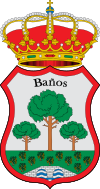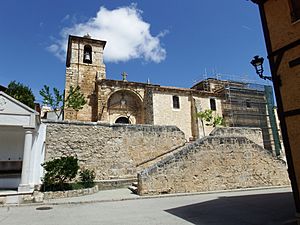Baños de Valdearados facts for kids
Quick facts for kids
Baños de Valdearados
|
|||
|---|---|---|---|
|
Municipality and town
|
|||
|
|||
| Country | Spain | ||
| Autonomous community | |||
| Province | |||
| Comarca | Ribera del Duero | ||
| Area | |||
| • Total | 37 km2 (14 sq mi) | ||
| Elevation | 890 m (2,920 ft) | ||
| Population
(2018)
|
|||
| • Total | 342 | ||
| • Density | 9.24/km2 (23.9/sq mi) | ||
| Time zone | UTC+1 (CET) | ||
| • Summer (DST) | UTC+2 (CEST) | ||
| Postal code |
09450
|
||
| Website | Banos de Valdearados official website: http://www.banosdevaldearados.es/ | ||
Baños de Valdearados is a small town and municipality in Spain. It is located in the province of Burgos, which is part of the Castile and León region. In 2018, about 342 people lived there.
Contents
What is Baños de Valdearados Like?
This town is about 16 kilometers (10 miles) from Aranda de Duero and 80 kilometers (50 miles) from Burgos. It sits 895 meters (2,936 feet) above sea level. The area around the town has gentle hills. The highest points are between 890 and 925 meters (2,919 and 3,034 feet) high.
The Bañuelos River flows through the municipality. This river is a branch of the larger Duero River.
Baños de Valdearados shares its borders with several other towns. To the south, it borders Quemada, Villanueva de Gumiel, and Aranda de Duero. To the west, it borders Tubilla del Lago and Gumiel de Izán. To the north, it borders Valdeande and Caleruega. And to the east, it borders Hontoria de Valdearados.
Most people living in Baños de Valdearados work in Aranda de Duero. Many also work in farming, especially growing grapes for wine and cereals like wheat.
The name "Baños" might come from "hot springs" because ancient hot springs were found here. These springs were called the "Source of Health." But some people think the name comes from a Latin word, "Vannos," which means "wasteland."
A Look Back in Time: History
In 1591, a survey of towns in the Crown of Castilla called this town "Vaños." It was part of the Arauces region in the province of Burgos. At that time, the region had 876 main families.
Later, the town was known as Arauzo de Valdearados. It was a royal town, meaning it belonged directly to the king, not to a noble. It was part of the Aranda de Duero area.
By 1843, Baños de Valdearados had 364 people living there.
Amazing Historical Sites
The area around Baños de Valdearados is full of historical treasures. One of the most important is the Roman Villa of Santa Cruz. This ancient Roman house was found by accident in November 1972. It's about 300 meters (984 feet) south of the town, near the road from Aranda. It has very special mosaic floors.
Other important buildings include:
- The Parish Church of Nuestra Señora de la Asunción: This church was built in the 1600s. It has a mix of old styles, including neoclassical and Renaissance influences.
- The Hermitage of Santo Cristo del Consuelo: This small church has an Elizabethan Gothic style front.
- The Hermitage of San Roque: Built in the 1600s.
- The Hermitage of Santa María Magdalena: This hermitage dates back to the 1500s.
Fun Festivals and Celebrations
Baños de Valdearados has many lively festivals throughout the year:
- Santa Águeda: Celebrated on February 5th. In the past, women would dance under the moonlight.
- Marzas: Held on the last day of February at midnight.
- Pilgrimage in honor of Santa María Magdalena: This special walk takes place on the Saturday before Ascension Thursday.
- Patron Saint Festivities: These are the main town parties, held on August 15th and 16th. They honor the Virgin of the Assumption and San Roque.
- Roman Festival: This festival celebrates the ancient Roman God Bacchus. It happens on the weekend after the main August festivities.
- Feast of the Exaltation of the Holy Cross: Celebrated on September 14th.
- Los Quintos: This tradition happens on December 31st, but sometimes also in the summer.
Famous People from Baños de Valdearados
- Zacarías Martínez Núñez (1864 – 1933): He was a very smart Augustinian friar and a biologist. He became a bishop in different Spanish areas. He studied with a famous scientist named Santiago Ramón y Cajal. Zacarías Martínez Núñez has streets named after him in several cities, including Baños de Valdearados.
- Deogracias Palacios del Río (1901 – 1936): He was an Augustinian Recollect priest. He was honored by Pope John Paul II in 1999.
See also
 In Spanish: Baños de Valdearados para niños
In Spanish: Baños de Valdearados para niños




